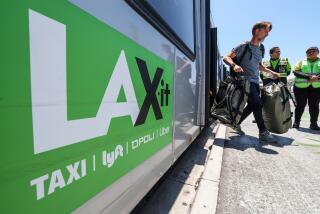As gas costs rise, taxi profit tanks
- Share via
Cab owner Mario Zamora is teetering on a precipice of high fuel prices.
Pacing around his shiny yellow taxi at Long Beach Airport, the 38-year-old father of five anxiously eyed the trickle of luggage-lugging travelers exiting the terminal.
He was still rattled by the 10-hour shift he put in a few days earlier, when he cleared just $30 after fuel and other expenses.
It was his worst day in seven years as a cabby.
“I was driving around, trying to get something,” he said. “I couldn’t get nothing, and I just burned gas.”
Long Beach gas prices have jumped about 50% since last summer, according to the Automobile Club of Southern California, and have more than doubled since summer 2004.
The added cost eats into Zamora’s profits.
He’s barred from charging customers more because the city sets fixed taxi rates. Records show fares have increased just 22% since 2001. Half of that boost came last summer, and it only partially offset gas increases from the previous two years.
Hour by hour, Zamora, stocky, intense and often in motion, wrestles with potentially costly choices:
Should he burn precious, $4.50-a-gallon gas cruising for customers? Or should he burn valuable time at a hotel or airport cab stand hoping he’ll catch a profitable fare?
“If I’m sitting around, I’m not making money,” he said. “[But] I don’t want to drive around [because] it’s wasting money.”
The decision wasn’t always so critical. Before the recent run-up in gas prices, Zamora routinely cruised the waterfront Convention Center area and the office and loft district looking for flag-down customers.
These days, he’s more likely to invest an hour or more creeping to the front of the line at cab stands, gambling for runs to LAX or Orange County. Those can bring in $50 or more and have become crucial to covering more than $100 in daily expenses -- about half of which is for gas.
But waiting only seems to intensify Zamora’s stress. He checks and rechecks the time on his cellphone and debates internally whether he should stay.
Often, the cab stand strategy doesn’t pay off. The average Long Beach trip is about five miles and brings in a little more than $14.
After an hour spent for a fare like that, Zamora usually rolls along downtown’s Pine Street or circles dining and entertainment venues.
“I have to risk it. I have to cruise around. I don’t have a choice.”
High fuel costs and a struggling economy are a double whammy, he said. Tourism, which accounts for several million visitors a year to the city, appears to be off.
Taxes collected on hotel stays are down slightly from last year, said Richard Bartlett, Long Beach’s business services officer.
Zamora’s children, 7 to 21, are all in school. He says his bills keep piling up.
“I don’t know how I’m going to make it,” he lamented this week, waiting at a cab stand outside a downtown hotel.
Unless something changes soon, he may have to sell the cab and try to find work as a warehouse manager or train for a new occupation
“There are no more good days,” he said.
--
--
On latimes.com
It’s like you’re there
Mario Zamora explains the situation as he stands near his taxi, waiting for a customer. Watch the video at
latimes.com/local.
More to Read
Sign up for The Wild
We’ll help you find the best places to hike, bike and run, as well as the perfect silent spots for meditation and yoga.
You may occasionally receive promotional content from the Los Angeles Times.






